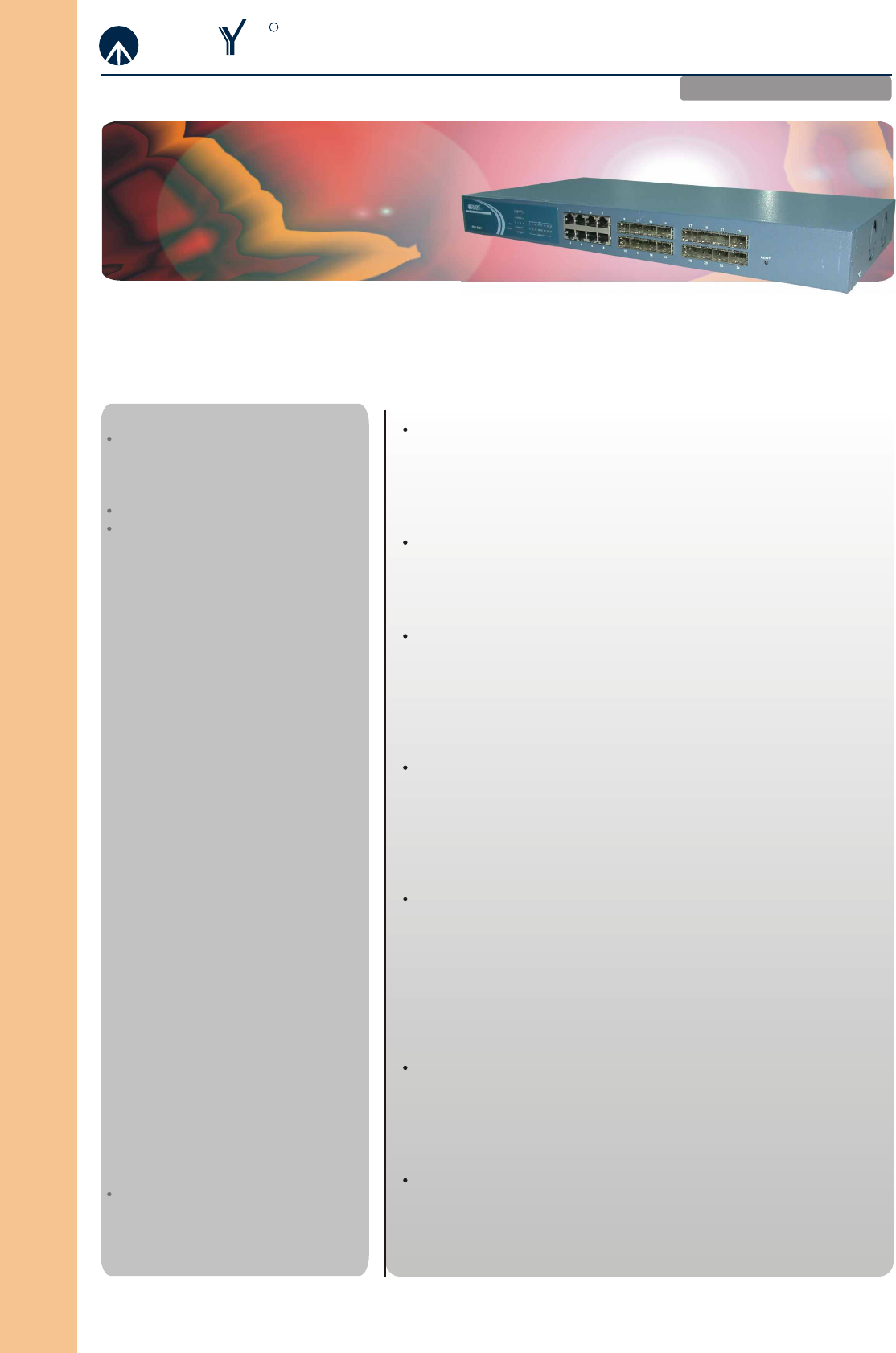
FGS-2824:
8-Port TP+16-Port SFP GbE L2 Managed Switch
Key FeaturesKey Features
Standard compliance
---IEEE 802.3x Flow Control capability
---IEEE 802.1q VLAN
---IEEE 802.1p
RoHS Compliance
Performance
Switching capacity:
---24 Gigabit Ethernet ports with non-
blocking wise speed performance.
---8 K MAC addresses
---400KB on-chip frame buffer.
---Supports Jumbo frame support, up to
9K
---Broadcast/Multicast Storm
Suppression
---Port Mirroring
VLAN
---Port-base VLAN
---IEEE802.1q tag-base VLAN, up to 256
active VLANs
---Q-in-Q is an efficient method for
enabling Subscriber Aggregation.
VSM(Virtual Stacking Management)
---Support 16 devices stacking
---Multiple switches can be managed via
one IP address, just like software
stacking
---Low cost and easily to establish
network environment, not extra
hardware require.
---Not center on the physical location of
wiring closets
Qos
---Supports Layer 4 TCP/UDP Port and
ToS Classification
---Supports 802.1p QoS with two level
priority queue
---Supports priority in a Q-in-Q tag
Bandwidth Control
---Supports Ingress, Non-unicast and
Egress Bandwidth rating management
with a resolution of 1Mbps
Protocol
LACP
---Port trunking with 8 trunking group
---Up to 12 ports for each group.
FGS-2824
BenefitsBenefits
QoS support layer 4 classification
The switch supports not only Layer 2 802.1p Priority Queue control, but also
supports programmable higher layer classification and prioritization to enable
enhanced Quality of Service (QoS) support for real time applications base on
information taken from Layer 2 to Layer 4, such as VoIP.
Port Mirroring Helps Supervisor Monitoring Network
Port mirroring copies traffic from a specific port to a target port. This
mechanism helps track network errors or abnormal packet transmission
without interrupting the flow of data.
Q-in-Q VLAN for performance & security
The VLAN feature in the switch offers the benefits of both security and
performance. VLAN is used to isolate traffic between different users and thus
provides better security. Limiting the broadcast traffic to within the same VLAN
broadcast domain also enhances performance. VLAN support enabling
advanced techniques such as "802.1Q-in-1Q" to be deployed.
802.3ad LACP for Bandwidth Aggregation
The Gigabit ports can be combined together to create a multi-link load-sharing
trunk. Up to 12 Gigabit ports can be set up per trunk for bandwidth up to
24Gbps, all traffic is aggregated based on MAC addresses, thus balancing the
traffic load. The switch supports up to 8 trunking groups. Port trunks are useful
for switch-to-switch cascading, providing very high full-duplex speeds.
802.1x Access Control Improve Network Security
802.1x features enable user authentication for each network access attempt.
Port security features allow you to limit the number of MAC addresses per
port in order to control the number of stations for each port. Static MAC
addresses can be defined for each port to ensure only registered machines
are allowed to access. By enabling both of these features, you can establish
an access mechanism based on user and machine identities, as well as
control the number of access stations.
802.1d Compatible & 802.1w Rapid Spanning Tree
For mission critical environments with multiple switches supporting STP, you
can configure the switches with a redundant backup bridge path, so
transmission and reception of packets can be guaranteed in event of any
fail-over switch on the network.
Broadcast/Multicast Storm Control
To limit too many broadcast/multicast flooding in the network, broadcast/
multicast storm control is used to restrict excess traffic. Threshold values are
available to control the rate limit for each port. Packets are discarded if the
count exceeds the configured upper threshold.
Gigabit Switch
Gigabit Switch
L2 Managed Switch
RUB
TECHTECH
Networking & Communications
R





